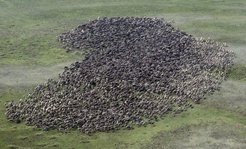Collective Computation in Large Animal Groups

Objectives: Despite the fact that social transmission of information is vital to many group-living animals, the organizing principles governing the networks of interaction that give rise to collective properties of animal groups, remain poorly understood. This project will employ an integrated empirical and theoretical approach to investigate the relationship between individual computation (cognition at the level of the ‘nodes’ within the social network) and collective computation (computation arising from the structure of the social network). The challenge for individuals in groups is to be both robust to noise, and yet sensitive to meaningful (often small) changes in the physical or social environment, such as when a predator is present. There exist two, non mutually- exclusive, hypotheses for how individuals in groups could modulate the degree to which sensory input to the network is amplified; 1) it could be that individuals adjust internal state variable(s) (e.g. response threshold(s)), effectively adjusting the sensitivity of the “nodes” within the network to sensory input and/or 2) it could be that individuals change their spatial relationships with neighbors (such as by modulating density) such that it is changes in the structure and strength of connections in the network that modulates the information transfer capabilities, and thus collective responsiveness, of groups. Using schooling fish as a model system we will investigate these hypotheses under a range of highly controlled, ecologically-relevant scenarios that vary in terms of timescale and type of response, including during predator avoidance as well as the search for, and exploitation of, resources. We will employ technologies such as Bayesian inference and unsupervised learning techniques developed in computational neuroscience and machine learning to identify, reconstruct, and analyze the directed and time-varying sensory networks within groups, and to relate these to the functional networks of social influence. As in neuroscience, we care about stimulus-dependent, history-dependent discrete stochastic events, including burstiness, refractoriness and habituation and throughout we will seek to isolate principles that extend beyond the specificities of our system.
Main adviser: Prof. Dr. Iain Couzin, MPI of Animal Behavior + University of Konstanz
